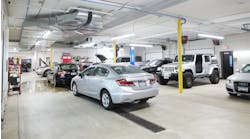Aftermarket associations have banded together to protest a “super warranty” that may lead to thousands of jobs and millions of dollars lost.
Even some OEs have taken a stand against these extended warranties — or 15-year, 150,000-mile “super warranties,” as they’re known — that were established as part of a clean air measure in California and a number of Northeastern states.
The California and Nevada Automotive Wholesalers’ Association (CAWA), along with seven other associations, petitioned the California Air Resources Board (CARB) in April to rescind the extended warranty, in a move that may eventually find its way to the legislative level.
CARB had 30 days to act on the petition, but at press time did not provide a response.
Convoluted beginnings
The groups take issue with the extended warranty’s true effectiveness in producing cleaner air and foresee the loss of jobs and independent repair dollars as a result.
The basis for these warranties is a confusing maze of definitions that apply to super low emission vehicles, zero emission vehicles and partial zero emission vehicles (PZEV), of which 100,000 are expected to hit the streets in California this year, with several million expected by 2010, according to a CARB spokesperson.
These vehicles are required to be a percentage of a vehicle manufacturer’s fleet.
The warranty regulations were enacted, in part, to make sure that even in poorer communities — where dirtier, less well-maintained vehicles are typically driven — drivers will have cleaner cars, says Jerry Martin, a CARB spokesperson. “Even when presumably younger people or people on limited incomes buy these cars, they’ll still be operating the cleanest cars in the world.”
Clean air results debated
Though enacted to lower automobile emissions, the extended warranties will not lead to cleaner air, attests Rodney Pierini, CAWA’s president and CEO.
A study commissioned through an independent research firm found the extended warranty is expected to divert approximately $500 million from independent repairs and cost about 2,500 jobs and lead to the closure of 700 businesses between now and 2008, according to Pierini, who adds that “super warranties” would also affect distributors.
These numbers don’t even address the possible “drag along” business that will be generated along with warranty repairs, according to AAIA.
If a vehicle is under warranty, the owner may be less likely to take precautionary measures to avoid failure of the emission system, according to the petitioners and other aftermarket leaders.
If CARB rejects the petition, “We’ll have to decide legislatively or legally what our next move is,” says Aaron Lowe, vice president of government affairs for AAIA.
He adds AAIA’s opposition goes beyond the potential loss of jobs for the aftermarket. “We have opposed this based on the fact that states should not get into the business of mandating warranties.”
OEs also see problems
In a departure from other hot-button industry issues, some OEs agree with the aftermarket stance on the requirements.
“We don’t think the overall requirements in California are a cost-effective way to reduce tailpipe emissions,” says Michael Love, national regulatory affairs manager for Toyota.
However, out of compliance, Toyota introduced a Camry in 2003 that meets PZEV regulations, as well as a recent Prius model.
GM chose not to comment on the extended warranties, only saying that it would comply with the rules.
These requirements also apply to a number of Northeastern states, including Maine, New Hampshire, New York and Massachusetts, according to Martin.
Though the mandate didn’t take effect until this year’s models were introduced, a number of manufacturers have already rolled out compliant vehicles. So far, 27 different models have been certified, including the Chrysler Sebring, Dodge Stratus, Kia Spectra and Nissan Altima.



